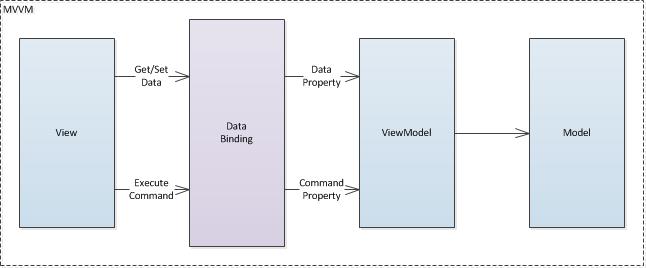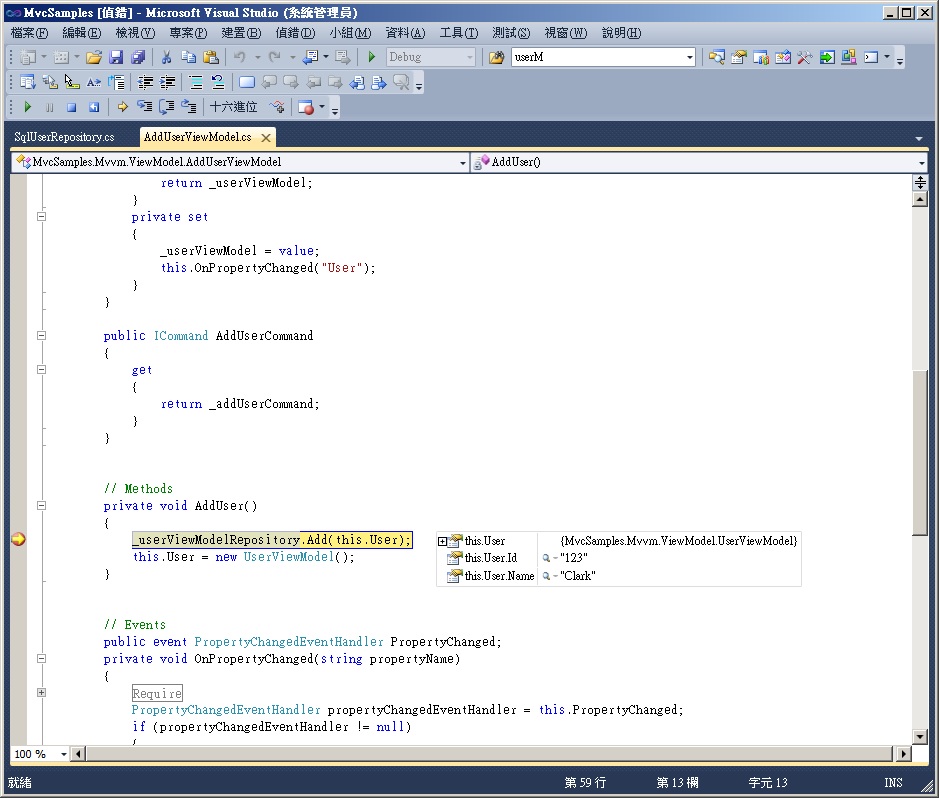[Application] : MVVM 模式
動機 :
開發應用程式的時候,針對使用者介面開發。
業界有許多前輩提出了多種的設計模式,其中最為人所知的就是 MVC模式。
MVC模式在實作上有許多種的方法,
不同的開發人員去理解它,都會有不同的理解。
不同的情景需求去套用它,也會有不同的實作。
但不論怎麼理解跟實作,它最基本的觀念依然都是:
「將系統職責拆解至 Model、View、XXX三種類別,並且定義它們之間的相依關係及溝通方式。」
在微軟.NET技術架構下,目前最為眾人討論的MVC延伸模式,
應該是適用 WPF、Silverlight、Windows phone平台的 MVVM模式 (Model-View-ViewModel)。
可以說近年微軟.NET架構下新推出的介面框架,多是主打套用這個設計模式。
本篇文章使用領域驅動設計的方式去分析設計,並且實作使用Domain Object的MVVM模式。
希望能透過這樣的方式,讓開發人員能對模式概念及如何實作有進一步的了解。
*這邊要強調,本文的設計模式都是概念式模式。每個人都有不同的理解跟實作,沒有誰是絕對正確的跟錯誤的。
相關資料可以參考 :
定義 :
在開始設計模式的實作之前,還需要為後續的實作加上一些定義。
*執行狀態
首先來討論「執行狀態」這個定義。
以HTML為基礎的Web網頁,屬於無狀態的應用程式模型。
而相對於它的WinForm應用程式,就屬於有狀態的應用程式模型。
投射到物件上,也是有相同的概念。
可以依照物件在系統執行生命週期裡,它的執行狀態是否留存在系統內,
來區分為有狀態的物件模型及無狀態物件模型。
「執行狀態」這個定義,會影響到實作設計模式的難易度。
當我們在一個無狀態的應用程式模型上,選擇實作某個有狀態的物件模型。
在這種情景下,執行狀態的維持就需要開發人員,在系統內作額外的設計。
*物件生成
再來討論「物件生成」這個定義。
當一個模式裡有多個物件在交互運作的時候,哪個物件從哪邊取得,是一件很重要的職責。
這裡所謂的取得,不單單是指所謂的建立(Creation),也包含了注入(Inversion)等動作。
「物件生成」這個定義,會影響到物件相依性、建立物件的順序及來源。
大多的設計模式都隱含了這個定義,但大多也都沒有特別描述這個定義。
因為這有太多的實作方式,各種不同的組合會帶來不同的效益。
但仔細參考設計模式文件的範例程式,可以去理解到各個設計模式隱含的物件生成職責。
範例 :
本篇文章物件模型拆解的比較瑣碎,建議開發人員下載範例程式後。
開啟專案做對照,能比較容易理解文字描述的內容。
範例原始碼 : 點此下載
實作 - Domain :
本文實作一個「新增使用者」的功能,來當作設計模式的範例。
這個功能情景很簡單,
1. 使用者輸入使用者資料。
2. 使用者資料存入 SQL資料庫。
3. 清空使用者資料等待輸入。
而使用者資料的欄位,單純的只有編號跟姓名兩個欄位。
依照這個功能描述,使用領域驅動設計的方式去分析設計。
我們可以先得到一個領域物件 User。
以及一個將 User資料進出系統的邊界介面 IUserRepository。
還有一個實際將 User資料存入 SQL資料庫的資料存取物件 SqlUserRepository。
後面的實作章節,將會使用這些物件,來完成「新增使用者」的功能。
using System;
using System.Data;
using System.Data.SqlClient;
namespace MvcSamples.Domain
{
public class User
{
// Properties
public string Id { get; set; }
public string Name { get; set; }
}
public interface IUserRepository
{
// Methods
void Add(User item);
}
}
namespace MvcSamples.Domain.Concretion
{
public class SqlUserRepository : IUserRepository
{
// Fields
private readonly string _connectionString = @"Data Source=.\SQLEXPRESS;AttachDbFilename=|DataDirectory|\Concretion\SqlMvcSamplesDatabase.mdf;Integrated Security=True;User Instance=True";
// Methods
private SqlConnection CreateConnection()
{
return new SqlConnection(_connectionString);
}
public void Add(User item)
{
#region Require
if (item == null) throw new ArgumentNullException();
#endregion
SqlCommand command;
using (SqlConnection connection = this.CreateConnection())
{
// Connection
connection.Open();
// Insert User
using (command = connection.CreateCommand())
{
command.CommandType = CommandType.Text;
command.CommandText = "INSERT INTO [User](Id, Name) VALUES (@Id, @Name)";
command.Parameters.AddWithValue("@Id", item.Id);
command.Parameters.AddWithValue("@Name", item.Name);
command.ExecuteNonQuery();
}
}
}
}
}
實作 - MVVM模式 :
*模式結構
下圖是MVVM模式的結構圖,很簡單的就是將系統拆解成三個類別 (Model、View、ViewModel)。
各個類別的主要職責為:Model負責企業資料邏輯、View負責畫面資料邏輯、ViewModel負責執行狀態維持、畫面流程邏輯及企業流程邏輯。
其中 ViewModel-Model之間,是 ViewModel直接使用 Model開放的成員,屬於ViewModel到Model的單向溝通連接。
而 View-ViewModel之間,是透過 Binding技術及Command的設計模式,將兩者作雙向的溝通連接。
*模式特徵
做為MVC延伸模式的MVVM模式,其最大的特徵就是,
在 View-ViewModel之間,是透過 Binding技術及Command的設計模式,將兩者作雙向的溝通連接。
並且在模型結構設計上,將ViewModel定義為有狀態的物件模型,由ViewModel負責維持執行狀態。
這樣設計最大的好處,是可以將View與ViewModel之間的相依關係,設計為單向相依。
ViewModel做是獨立的個體不相依View,讓View的職責回歸到單純的完成輸入及顯示的工作。
並且方便特定的設計工具設計View的外觀,可以將View的設計交由完全不懂程式設計的人員作處理。
*實作分析
1. MVVM模式本身在模型結構設計上,是將ViewModel設計為有狀態的物件模型。
實作範例的內容,將ViewModel架構在有狀態的應用程式模型上,不做額外的設計。
2. 而 MVVM模式物件之間的生成模式,實作上設計成以View當作主要物件,生成ViewModel及Model,並且將Model注入至ViewModel。
3. 以DDD的觀念去分析Model,可以將Model視為Domain Layer。
這個Domain Layer裡面,包含了整個系統會使用到的資料物件、邊界物件、邏輯物件...等等。
4. 以DDD的觀念去分析ViewModel,可以將ViewModel視為Application Layer。
這個Application Layer封裝View所需要的資料、操作及狀態維持,用來提供給View使用。
經過這些分析與設計的種種考量,可以設計出如下圖的物件圖。
*實作程式
有了物件圖,剩下的就只是建立物件的實作程式碼。
這邊選擇能簡易套用 MVVM的 WPF當做範例的介面框架,示範如何實作MVVM模式。
首先先建立一個ActionCommand物件,讓我們後續方便把函式包裝成Binding所支援的ICommand。
using System;
using System.Windows.Input;
namespace MvcSamples.Mvvm.Infrastructure
{
public class ActionCommand : ICommand
{
// Fields
private readonly Action _action = null;
private bool _canExecute = true;
// Constructor
public ActionCommand(Action action)
: this(action, true)
{
}
public ActionCommand(Action action, bool canExecute)
{
#region Require
if (action == null) throw new ArgumentNullException();
#endregion
_action = action;
_canExecute = canExecute;
}
// Methods
public void SetCanExecute(bool canExecute)
{
_canExecute = canExecute;
this.OnCanExecuteChanged(this, EventArgs.Empty);
}
public bool CanExecute(object parameter)
{
return _canExecute;
}
public void Execute(object parameter)
{
if (this.CanExecute(parameter) == false)
{
throw new InvalidOperationException();
}
else
{
_action();
}
}
// Events
public event EventHandler CanExecuteChanged;
private void OnCanExecuteChanged(object sender, EventArgs e)
{
#region Require
if (sender == null) throw new ArgumentNullException();
if (e==null) throw new ArgumentNullException();
#endregion
EventHandler eventHandler = this.CanExecuteChanged;
if (eventHandler != null)
{
eventHandler(sender, e);
}
}
}
}
再來建立UserViewModel物件,封裝提供給View使用的資料與操作。
並且加上UserViewModelRepository物件、IUserViewModelRepositoryProvider介面,做為UserViewModel進出邊界的介面。
using System;
using System.Collections.Generic;
using System.Linq;
using System.Text;
namespace MvcSamples.Mvvm.ViewModel
{
public interface IUserViewModelRepositoryProvider
{
// Methods
void Add(UserViewModel item);
}
}
using System;
using System.Collections.Generic;
using System.Linq;
using System.Text;
namespace MvcSamples.Mvvm.ViewModel
{
public class UserViewModelRepository
{
// Fields
private readonly IUserViewModelRepositoryProvider _provider = null;
// Constructor
public UserViewModelRepository(IUserViewModelRepositoryProvider provider)
{
#region Require
if (provider == null) throw new ArgumentNullException();
#endregion
_provider = provider;
}
// Methods
public void Add(UserViewModel item)
{
#region Require
if (item == null) throw new ArgumentNullException();
#endregion
_provider.Add(item);
}
}
}
using System;
using System.Collections.Generic;
using System.Linq;
using System.Text;
using System.ComponentModel;
namespace MvcSamples.Mvvm.ViewModel
{
public class UserViewModel : INotifyPropertyChanged
{
// Fields
private string _id = null;
private string _name = null;
// Constructor
public UserViewModel()
{
_id = string.Empty;
_name = string.Empty;
}
// Properties
public string Id
{
get
{
return _id;
}
set
{
_id = value;
this.OnPropertyChanged("Id");
}
}
public string Name
{
get
{
return _name;
}
set
{
_name = value;
this.OnPropertyChanged("Name");
}
}
// Events
public event PropertyChangedEventHandler PropertyChanged;
private void OnPropertyChanged(string propertyName)
{
#region Require
if (string.IsNullOrEmpty(propertyName) == true) throw new ArgumentNullException();
#endregion
PropertyChangedEventHandler propertyChangedEventHandler = this.PropertyChanged;
if (propertyChangedEventHandler != null)
{
propertyChangedEventHandler(this, new PropertyChangedEventArgs(propertyName));
}
}
}
}
接著就是建立AddUserViewModel物件,封裝提供給View使用的資料與操作。
using System;
using System.ComponentModel;
using System.Windows.Input;
using MvcSamples.Mvvm.Infrastructure;
using MvcSamples.Mvvm.ViewModel;
namespace MvcSamples.Mvvm.ViewModel
{
public class AddUserViewModel : INotifyPropertyChanged
{
// Fields
private readonly UserViewModelRepository _userViewModelRepository = null;
private readonly ICommand _addUserCommand = null;
private UserViewModel _userViewModel = null;
// Constructor
public AddUserViewModel(UserViewModelRepository userViewModelRepository)
{
#region Require
if (userViewModelRepository == null) throw new ArgumentNullException();
#endregion
_userViewModelRepository = userViewModelRepository;
_addUserCommand = new ActionCommand(this.AddUser);
_userViewModel = new UserViewModel();
}
// Properties
public UserViewModel User
{
get
{
return _userViewModel;
}
private set
{
_userViewModel = value;
this.OnPropertyChanged("User");
}
}
public ICommand AddUserCommand
{
get
{
return _addUserCommand;
}
}
// Methods
private void AddUser()
{
_userViewModelRepository.Add(this.User);
this.User = new UserViewModel();
}
// Events
public event PropertyChangedEventHandler PropertyChanged;
private void OnPropertyChanged(string propertyName)
{
#region Require
if (string.IsNullOrEmpty(propertyName) == true) throw new ArgumentNullException();
#endregion
PropertyChangedEventHandler propertyChangedEventHandler = this.PropertyChanged;
if (propertyChangedEventHandler != null)
{
propertyChangedEventHandler(this, new PropertyChangedEventArgs(propertyName));
}
}
}
}
繼續建立UserViewModelRepositoryProvider,用來讓整個模式跟Domain連接。
using System;
using System.Collections.Generic;
using System.Linq;
using System.Text;
using MvcSamples.Mvvm.ViewModel;
namespace MvcSamples.Mvvm.ViewModel.Concretion
{
public class UserViewModelRepositoryProvider : IUserViewModelRepositoryProvider
{
// Fields
private readonly MvcSamples.Domain.IUserRepository _userRepository = null;
// Constructor
public UserViewModelRepositoryProvider(MvcSamples.Domain.IUserRepository userRepository)
{
#region Require
if (userRepository == null) throw new ArgumentNullException();
#endregion
_userRepository = userRepository;
}
// Methods
private MvcSamples.Domain.User CreateUser(UserViewModel item)
{
#region Require
if (item == null) throw new ArgumentNullException();
#endregion
MvcSamples.Domain.User user = new MvcSamples.Domain.User();
user.Id = item.Id;
user.Name = item.Name;
return user;
}
public void Add(UserViewModel item)
{
#region Require
if (item == null) throw new ArgumentNullException();
#endregion
_userRepository.Add(this.CreateUser(item));
}
}
}
建立完上述的程式碼之後,額外再加一個AddUserViewModelHost。
用來提供無參數的建構物件,方便後續作Binding的操作。
using MvcSamples.Domain;
using MvcSamples.Domain.Concretion;
using MvcSamples.Mvvm.ViewModel;
using MvcSamples.Mvvm.ViewModel.Concretion;
using MvcSamples.Mvvm.ViewModel;
namespace MvcSamples.Mvvm.Runtime
{
public class AddUserViewModelHost
{
// Fields
private AddUserViewModel _viewModel = null;
// Properties
public AddUserViewModel ViewModel
{
get
{
if (_viewModel == null)
{
_viewModel = this.Create();
}
return _viewModel;
}
}
// Methods
private AddUserViewModel Create()
{
IUserRepository userRepository = new SqlUserRepository();
IUserViewModelRepositoryProvider userViewModelRepositoryProvider = new UserViewModelRepositoryProvider(userRepository);
UserViewModelRepository userViewModelRepository = new UserViewModelRepository(userViewModelRepositoryProvider);
return new AddUserViewModel(userViewModelRepository);
}
}
}
最後就是建立顯示用的XAML。
<Window x:Class="MvcSamples.Mvvm.WpfDemoApp.MainWindow"
xmlns="http://schemas.microsoft.com/winfx/2006/xaml/presentation"
xmlns:x="http://schemas.microsoft.com/winfx/2006/xaml"
xmlns:viewModel="clr-namespace:MvcSamples.Mvvm.ViewModel;assembly=MvcSamples.Mvvm"
xmlns:runtime="clr-namespace:MvcSamples.Mvvm.Runtime;assembly=MvcSamples.Mvvm"
Title="MainWindow" Height="350" Width="525">
<Window.Resources>
<runtime:AddUserViewModelHost x:Key="addUserViewModelHost" />
</Window.Resources>
<Window.DataContext>
<Binding Source="{StaticResource addUserViewModelHost}" Path="ViewModel" Mode="OneTime" />
</Window.DataContext>
<Grid>
<TextBox Name="textBox1" Height="23" Margin="10,10,0,0" VerticalAlignment="Top" HorizontalAlignment="Left" Width="120" DataContext="{Binding User}" Text="{Binding Id}" />
<TextBox Name="textBox2" Height="23" Margin="10,39,0,0" VerticalAlignment="Top" HorizontalAlignment="Left" Width="120" DataContext="{Binding User}" Text="{Binding Name}" />
<Button Name="button1" Height="23" Margin="55,68,0,0" VerticalAlignment="Top" HorizontalAlignment="Left" Width="75" Content="Button" Command="{Binding AddUserCommand}" />
</Grid>
</Window>
結果 :
編譯後執行, 在畫面上輸入資料並按下按鈕。於程式的中斷點做檢查,可以發現程式有正常執行。
能以更簡潔的文字與程式碼,傳達出程式設計背後的精神。
真正做到「以形寫神」的境界。




